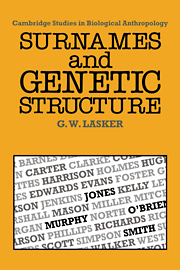Book contents
- Frontmatter
- Contents
- Preface
- 1 Introduction
- 2 History of surname studies in human biology
- 3 Sources of data
- 4 Methods
- 5 Isolates and inbreeding
- 6 Island versus distance models: the Far East and Oceania
- 7 The Americas and continental Europe
- 8 Scotland and Ireland
- 9 Regions of England
- 10 English cities and the general population of England and Wales
- 11 Specific surnames in Great Britain
- 12 Human population structure
- Literature cited
- Appendix maps and diagrams, of the distribution of 100 surnames in England and Wales
- Glossary
- Index
9 - Regions of England
Published online by Cambridge University Press: 05 November 2011
- Frontmatter
- Contents
- Preface
- 1 Introduction
- 2 History of surname studies in human biology
- 3 Sources of data
- 4 Methods
- 5 Isolates and inbreeding
- 6 Island versus distance models: the Far East and Oceania
- 7 The Americas and continental Europe
- 8 Scotland and Ireland
- 9 Regions of England
- 10 English cities and the general population of England and Wales
- 11 Specific surnames in Great Britain
- 12 Human population structure
- Literature cited
- Appendix maps and diagrams, of the distribution of 100 surnames in England and Wales
- Glossary
- Index
Summary
North of England
The population structure of part of Northumberland has been studied by the method of surname analysis. Dobson (1973) examined the parish records of four ecclesiastical parishes that lie along the valley of the River Coquet, and found that the retention of surnames in the population was similar in the four parishes. Of the surnames present in 1780–1809, 47–53% had been present in the same parish in 1720–49 and 39–41% had been present in 1690–1719. The further apart a pair of parishes, the fewer surnames they shared. Analysis of the surnames plus an examination of marital distances led Dobson to conclude that the population structure, and amount and distance of gene flow, led to effective population sizes too large to permit local genetic differentiation. Nevertheless, there was much less gene flow into these parishes than into that of Horringer in East Anglia where of the surnames present at the end of the eighteenth century only 2% had been present in the latter part of the seventeenth century (Buckatzsch, 1951).
One of the Northumbrian parishes, Warkworth, was further studied by Rawling (1973). After merging different spellings of the same surnames there were 22 instances of isonymous unions in the period from 1686 to 1812. Eighteen of these were endogamous marriages and four exogamous marriages. The amount of inbreeding, and especially the size of the non-random component, increased with time. However, the random component actually decreased, although perhaps not statistically significantly.
- Type
- Chapter
- Information
- Surnames and Genetic Structure , pp. 54 - 61Publisher: Cambridge University PressPrint publication year: 1985



